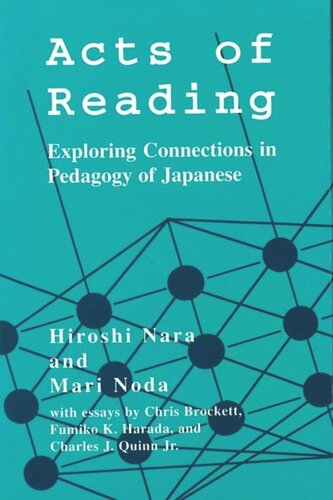

Most ebook files are in PDF format, so you can easily read them using various software such as Foxit Reader or directly on the Google Chrome browser.
Some ebook files are released by publishers in other formats such as .awz, .mobi, .epub, .fb2, etc. You may need to install specific software to read these formats on mobile/PC, such as Calibre.
Please read the tutorial at this link: https://ebookbell.com/faq
We offer FREE conversion to the popular formats you request; however, this may take some time. Therefore, right after payment, please email us, and we will try to provide the service as quickly as possible.
For some exceptional file formats or broken links (if any), please refrain from opening any disputes. Instead, email us first, and we will try to assist within a maximum of 6 hours.
EbookBell Team

4.0
46 reviewsStudents who have completed a year of German read Brecht in their second year, those of Spanish read Cervantes. Teachers of first and second-year Japanese can often find nothing comparable. "Why aren't your students reading literature?" they are asked. "Why not Soseki? Or Murakami?" What are instructors of Japanese doing wrong?
Nothing, according to the authors of this volume. Rather, they argue, such questions exemplify the gross misunderstandings and unreasonable expectations of teaching reading in Japanese. In Acts of Reading, the authors set out to explore what reading is for Japanese as a language, and how instructors should teach it to students of Japanese. They seek answers to two questions: What are the aspects of reading in Japan as manifested in Japanese society? What L2 (second-language) reading problems are specific to Japanese? In answering the first and related questions, the authors conclude that reading is a socially motivated, purposeful act that is savored and becomes a part of people's lives. Reading instruction in Japanese, therefore, should include teaching students how to work with text as the Japanese do in Japanese society.
The second question relates more directly to traditional concerns in L2 reading. The authors begin with a general theory of reading. They then offer a welcome glimpse into the rich and complex perspectives-sometimes conflicting, other times symbiotic-on what reading is and how it is performed in L1 and L2, and, most importantly, on the web of interconnections between the phenomenology of reading and the demands it places on teaching approaches to reading in Japanese.
With essays by Charles J. Quinn, Jr., Fumiko Harada, and Chris Brockett
Foreword by J. Marshall Unger